My Headphone Review Page
I thought I'd post up my reviews of the various headphones I've reviewed over time. I'll start from the earliest and progress to the latest:Sony MDR-V5
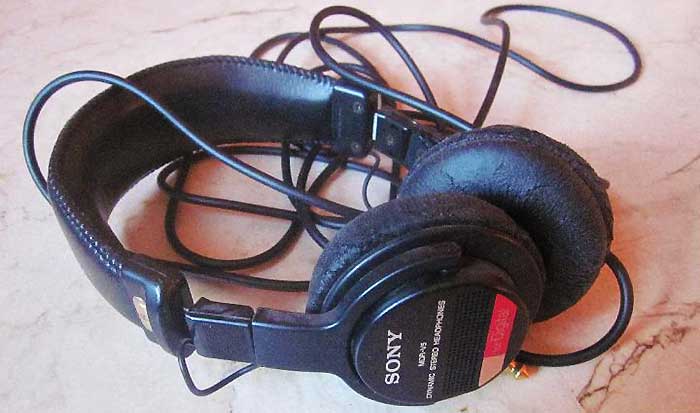
My first "proper" set of Hi-Fi headphones, given as a birthday present from my brother. Lovely sound which was very detailed and blew away many others from that time (about 1990), with great bass and sparkly highs. You can read more about their bigger brother over here.
Panasonic 16mm earbuds

Still back in the early 90's, I bought an expensive cassette player to listen to music on the go. It cost around £85 and was a Panasonic RQ-S15 Walkman. It looked and sounded fantastic and bundled with it was a pair of 16mm earbuds. The remote on the wire allowed full control based on the number of times you pressed the single button (something copied by Apple and it's iPod/iPhones a decade later). The sound, from memory, was full bodied with a bass extension switch should you need it. It lasted me about 6-7yrs of continuous use and the only reason I stopped listening to it was that it broke one day but was not repairable...so along came the replacement...
Sony 16mm earbuds
Bundled with the WM-EX811 Walkman, these earbuds gave a much clearer sound with better imaging at the expense of bass-weight. Unfortunately despite being the best looking portable machine I owned in anodised light blue/lilac and adding a full digital LCD remote, it broke within 1yr and as it was bought abroad, I had no warranty with which to get it fixed...so along came a further replacement...Aiwa 17mm earbuds
Bundled with the HS-PX747 mkii Walkman, these earbuds upped the anti by including a 17mm set of drivers for better bass and retaining a nifty digital display which by now had become "standard" on the remotes. Despite this, it wasn't a patch on my old S15.Sennheiser HD480 mkii
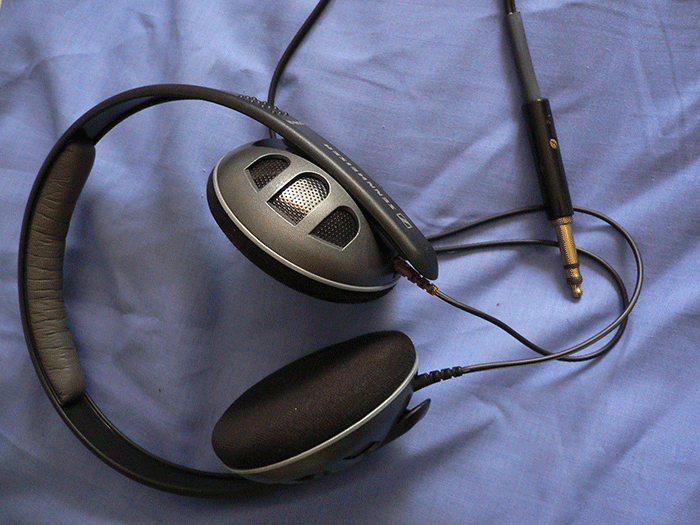
Superb in every area (deep bass, fluid midrange, smooth treble, fast transients, wide soundstage etc etc), I bought these for my Hi-Fi and absolutely loved them...so much so that even though my original's gave up the ghost when I was in uni', I have since re-bought them as ex-BBC NOS.
The only difference with this new set is that they used a PO316 connector (aka B-gauge - pictured) which was an extremely rugged format originally designed for telephone switchboards and balanced audio circuits. It's different to a normal Hi-Fi A-guage as it is rounded and slightly smaller than the more angular, enlarged tip of the A-gauge. This means that inserting a B-gauge plug into a Hi-Fi ¼" socket results in a very dodgy connection, as the contacts will barely reach the thinner-bodied plug. This meant that I had issues when inserting into my MF-Xcans, so I cut it off and soldered a "normal" hi-fi A-Guage into it's place. On top of this, they are 1700Ω impedance making them very hard to drive, so if you buy them, you'll need a powerful headphone amp in order to get the best out of them.
Going back to the sound, my original low-impedance version cans were so good that they were pretty much my 'reference' set for a long time. I think it's fair to say that these are pretty much eclipsed by the Momentum's now (see below).
Sennheiser HD575 Symphony
The HD575's are a limited-edition headphone, not one of Sennheiser's "regular" models. They (at 120 ohms impedance and 101dB sensitivity) can be adequately driven by many portable audio players, but do sound better when driven with an amp. They are basically the HD590's in a HD570 shell, tweaked for classical music listening. Unfortunately they also sound terrible compared to the HD480 mkii which have great balance. These 575's have way too much treble. I initially fixed this by placing a sheet of tissue paper into the cup and edging it under the foam rim to keep it in place. They then sounded better, so i'd give them a 6/10 with this 'fix' (bass is great and detailed, more midrange shines through, because the tissue has tamed the overbright treble).I believe that headphones should not have to be tweaked in order to sound 'right' so I have since donated these to my nephew.
Sony MDR-EX71slw
These were not a very good pair of earphones:Treble: Very harsh/shrill at high volumes. I had my iPod uncapped using GoPod, but then re-capped it to Euro 100dB max as above this, treble was too bright. Below this, though, treble was more acceptable (and more midrange manages to elbow its way through - shouldn't be listening to them too loudly anyway).
Midrange: Not very noticeable most of the time (esp. at higher levels) as it's drowned out by splashy (screechy) treble and overblown bass.
Bass: Yes it's there, but nowhere near as good as any over-the-ear pair, being less well formed and less accurate too.
Fitting: Beautiful...too good in fact. In fact, so good that whereas before I used to simply turn the volume down/off to listen to people, I now have to take them out completely - no ambient noise at all - the bonus is that you therefore don't need such high volumes to hear the music (my iPod is usually set around the halfway mark now). Probably the most comfortable in ear phones i've used (btw-the inserts do make a difference, I've found medium sounds best). I have since tried this to improve the sound...
Get some simple cotton wool ear buds, pull some of the cotton wool off the end. Insert a small amount (enough to fill to the rim of the grey "caps" snugly) into the ends. Voila: Bass remains unaffected, Midrange pretty much the same, but now the treble is markedly reduced......overall loudness also is reduced.
Overall:...in hindsight, even with my "cotton wool" fix, treble can still be a bit too harsh a lot of the time. You shouldn't need to do anything to 'phones to make them acceptable...that's why it only gets 3-4/10 (at a push!). I now wish i'd bought alternate earbuds instead......why do companies insist on tuning the sound for people who think accuracy of sound means you need to have piercingly high levels of (splashy) treble?
Anyway, they're not worth it unless you happen to like massive amounts of treble with no midrange and innaccurate bass reproduction.
Sennheiser CX300
The sound quality is superb, and they far outclass my other Sony MDR-EX71slw 'phones. I also have the excellent Sennheiser PX100's which I'll try to compare to.Bass: Excellent and deep. Unlike the Sony's however, they don't output overblown baggy bass, it is very tight and tuneful and FAST (Bass starts and stops on a dime with the CX300's). To give an example, various dance tracks that have complex bass-lines tended to come over as a slightly homogenous deep sound only on the Sony's, whereas here they are easily distinguishable from each other...all separated, present and correct.
The Sennheiser PX100's don't reach as deep, but they do tend to vibrate instead...thus giving the impression of deep deep bass (whereas with the CX300's, it's real !)
Midrange:...lovely liquid midrange here. Stands out nice and clear, vocals sound like they're physically in your head. Unlike the Sony's, NOT drowned out amongst shrill treble and inaccurate bass. The midrange is as clear and well proportioned as the PX100's.
Treble: Yes, OK, they do have slightly high treble on first listen, but you need to burn them in first (a week or so of continuos listening should do the trick). When they settle down, they're amazing too. Treble is nicely placed, giving the impression of a nice wide soundstage (to the extent that sounds appear to come from not only inside your head, but also around you sometimes). The treble in the PX100's is also very clear, giving the impression of nice open soundstage (slightly more expansive too) but the Sony's, conversely, are terrible screechy rubbish.
Build Quality: Exemplary. Better than the PX100's (which are excellent anyway) my silver CX300's aren't simply covered in cheapo silver paint/plastic. It actually looks like metallic car paint with a few coats of piano gloss veneer over it (I was a bit worried that I hadn't opted for the "safe" black ones, but the silvers look great imho). The material is also very solidly put together. In this respect, you get the impression manipulating them in your fingers of a classy piece of kit. The Sony's, on the other hand, have appalling build quality using cheap nasty materials.
Comfort: Again top notch. So comfortable that you forget you're wearing them. They're supplied with 3 sizes of rubber "canal-piece" so you have choice like the Sony's. For comfort I'd rate these as high as the Sony's and this also means very little sound leakage. The PX100's, while good, aren't quite this good and you also get more sound leakage with them.
Overall Good Points: Accurate, deep and tuneful bass, liquid clear midrange, nice treble that gives a sense of good soundstage, excellent build quality and they are VERY comfortable
Overall Bad Points: Treble quite high initially (but should improve with time) and they have a slightly expensive RRP, but you should be able to get at least a third off this online
Summary: These are FANTASTIC headphones. Compared to the PX100's the CX300's sound is very similar with only the soundstage being not as wide and open, but traded off for a much nicer fit with less sound leakage. I would also say that I use the PX100's when I also need ambient sound intrusion (like on a bike), and the CX300's when I don't want to disturb others (on the train). The Sony's come in a distinct 3rd in all departments apart from comfort. I'd give them 6/10.
P.S....some people have commented that the CX300's are 're-badged' Creative EP630's. This is not true...example CX300 = 18-21kHz, 112dB, asymmetric cord ... but ... EP630 = 6-23kHz, 106dB, symmetrical cord. Creative just copied the Senny's design is all...they are not the same headphone (different drive units and wiring).
Sennheiser PX100 & PX100ii

I've done a comparison in the CX-300 review but suffice it to say, these have a nice open soundstage, sweet treble and good mids and bass. They are an overall excellent set of cans as evidenced by the fact that they started out with an RRP of around £25 but this has almost doubled to a current RRP of £45 because they are so good, universally attracting praise from critics.
Update: So my PX100 headband broke after many years of faithful service, so I have "re-"brought the newer model, the PX100ii.
Construction: The headphones have similar drivers but are otherwise made from different materials with a modified construction. Whereas the PX100 looked very retro, the mkii has an updated appearance and looks far classier imo. From the more svelte looking backs to the attention to detail with the name precisely printed on the surface, they look much nicer (especially being black rather than silver). Importantly, now there is only one wire leading to the 'phones going to the left cup, unlike the original which had one each which will make taking them off/putting them on easier. Along with this, they have changed the 3.5mm jack from a straight one to a right angled one which is much better for portable use especially when you have an iPhone/iPod in your pocket. Even the foam earpads have changed with the foam having a bit of "memory" and slightly stiffer for moulding around the ear with a higher quality feel, whereas the original had very '70s style simple foam pieces on that aren't as comfortable and don't feel as upmarket.
Sound: They sound is very slightly updated to. Gone is the laid back sound of the fairly neutral PX100s, along comes a more upfront, in your face performance with a deeper, more thumpy bass and enhanced treble in the mkiis. The bass isn't bloated but is very tuneful whilst the treble is higher but can sound a bit screechy with poorly compressed music. Unfortunately, this comes at the expense of the midrange which seems to have taken a bit of a backseat now. They mkiis still have a fairly neutral presentation, but Sennheiser have decided to add a little 'oomph' to proceedings. Put another way, if listening to high energy tracks like dance or rock, I'd use the mkiis, whereas if listening to more laid back tracks like soul or jazz, I'd stick with the originals.
Overall: Still highly recommended 'phones, but slightly less VFM than the originals due to the new price hike, they get 7/10.
Sennheiser IE6

I got these on sale for £40 (RRP £140) and use them extensively. They come with a snazzy case and a whole host of single or double flange eartips (Small, Medium or Large for each type). The only problem then was getting the right types to fit. At one point I thought I'd need large double flange in my left ear and medium single flang in my right! I think experimenting not just with flange type/size but also how they sit in your ears will deliver different results regarding the bass.
I've now settled (I think) on using Comply Foam Tips for both ears and on repeated listens I think the bass is fantastic (extends like the CX300's, but less "muddy" and therefore filled with more detail - I can discern different bass-lines with these when comparing the same tracks).
The sound? Bleedin' brilliant for the small outlay. The bass isn't as deep as my CX300's and the sound is maybe similarly (not more) isolated, but they improved after using them for a couple of hundred hours or so (although regarding "burn in" it could all be placebo). Apart from that, they sound far more open and detailed than the CX300's (with a soundstage as good as the PX100's), with great midrange and sparkling treble - they really add a "dynamism" to the sound, great for dance/hiphop - just tried the Gorillaz album "Plastic Beach" using them and it sounds brilliant.
With regards to wearing them, you can wear them with cords dangling down rather than up, but this is not the right way to do it.
Test: hold them up from the cords (i.e. equivalent to how they're recommended to be worn by hooking wire over ears). Now look at the ear buds. They're pointing forwards. Just like a stethoscope. Now hold them up by the "bodies" (with wire hanging down) still with R in your right hand and L in your left. Notice anything? Yes, the buds are now pointing backwards. Do you know why stethoscopes point forwards? It's because our ear canals do. So do these headphones (when worn as recommended).
So if you want the best ("designed for") sound, wear them up and over your ears as the manual says. This way the ear buds face forwards into the length of our ear canals rather than back into the posterior wall.
Overall: I'm a very happy bunny with these, and for the price I paid I'm even happier. I'd give them 8/10.
Sony MDR-DS6500
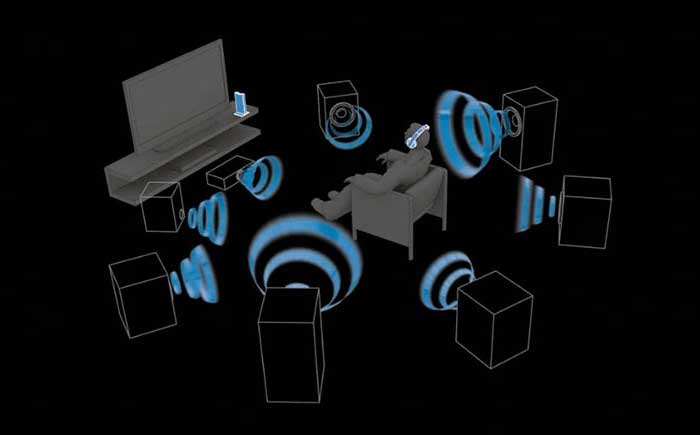
OK, I know these aren't Hi-Fi but they're excellent for films and gaming. Wireless so no messy cords to deal with (although they interfere with the b/g wifi network on the 2.4Ghz band). Importantly, they accept an optical digital input from any source either as 7.1 or 5.1 channel or they up-mix a 2 channel signal via Dolby Prologic II. They can decode both Dolby Digital as well as DTS soundtracks. The result is convincing surround sound inside your head whilst you don't disturb others.
I have mine set up so that the PS4 sends BluRay and Game info via optical separate to the TV. Overall, movies and films sound great, although your ears do get hot after a time so unlike the HD480 or Momentum, you can't wear them all day.
Having said that I would still recommend them as great headphones for non-Hi-Fi purposes.
Sennheiser Momentum

I seem to have good luck with Sennheisers on sale at Hoomv - my last acquisition being some IE6's for the princely sum of £40 ...I think I've just topped it with the "blue cross sale" giving 40% off headphones, including the Sennheiser Amperior's and the Momentum's. Normal RRP of £260 down to £156 on sale - brand new.
Before I start: I wouldn't recommend buying ANY headphones as expensive as this without listening first. HMV won't let you, but luckily John Lewis did.
I wasn't at all impressed with the Amperior's (they just sounded a bit crap to me, all shouty with flabby bass like they're trying to emulate the Monster Beats ones), but the new B&W P3 caught my eye (and my ear). In fact, it sounded better than the P5 imo...so I was about to get a pair but they had run out of black (grubby white only). Whilst looking, I tried out the Momentum and thought "Wow - these are good, but are they worth £100 more than the P3?". Naturally, now that they're on sale for the same P3 price, I jumped at the chance (seeing as these senny's are definitely a step up from the P3's - but more on that later).
Packaging: The box is fairly standard fair. Open it up and inside is what can only be described as a behemoth of a case. Portable this is not:
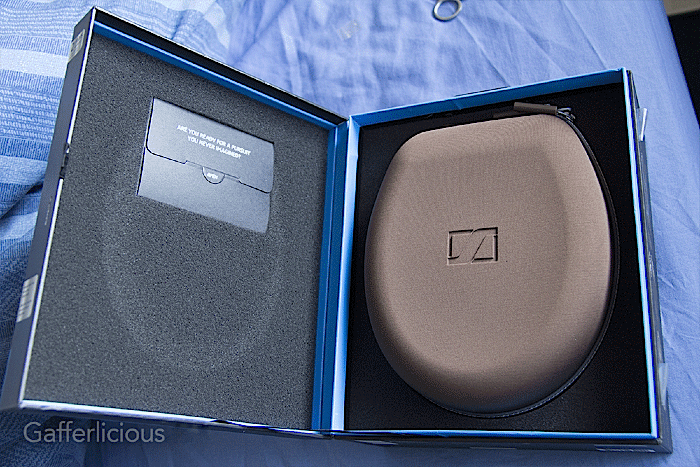
Open the small "wallet" on the left and the standard instruction manuals appear. Open the large case on the right and you're greeted by a great looking set of headphones:

Other accessories include 2 types of wire, one for iPhones with built in remote and a very nice hinged 35mm jack and t'other a "standard" wire with no remote. Also included is the obligatory ¼" jack for hi-fi use:

The Headphones themselves look great in a kind of WWII retro style, with lots of metal and leather:
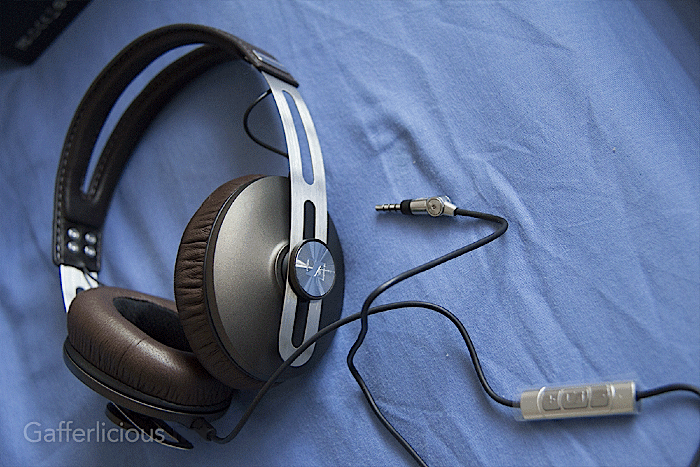
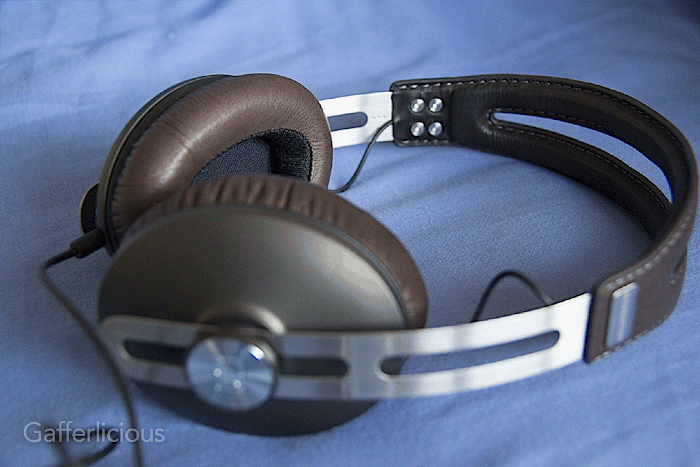
The cups that look bronzed are plastic, which adds to the lightness, but more importantly, the leather and metal headband ensures a VERY comfortable fit. I have some Sony Surround sound headphones too and these Momentum's are by far the more comfortable pair.
Listening to an iPhone: These headphones are meant to be a low impedance (18Ω) type for use with things like iPods, but I found them fairly quiet on the iPhone. I therefore decided to use the "standard" wire, which involved removing the iPhone one which you have to twist to do because it is notched to prevent it falling out:
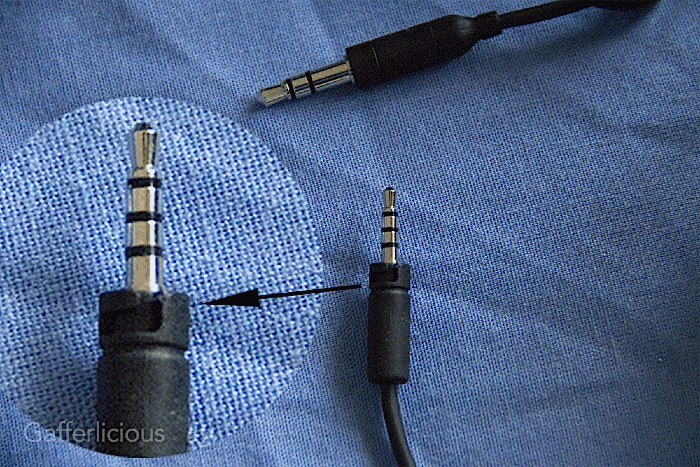
So DON'T try to pull them straight out of the headphone cup because you'll break the wire. Including the twist mechanism means a more secure fit for the jack into the cup.
Why the normal wire? Because I feel these need a tiny bit more "oomph" which can be provided by my Fiio amp which doubles up as an iPhone remote anyway, complete with volume control (something not all remotes have):
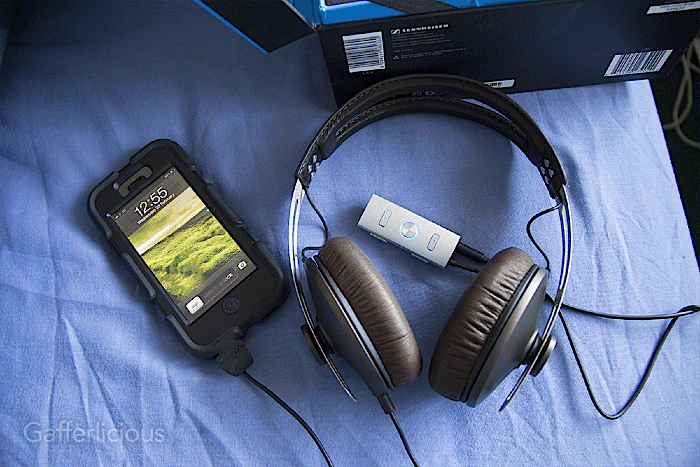
More on the comfort - having only 1 side "wired" is a plus worth mentioning as they're not only easy to wear, but easy to take off too.
OK, that's enough babbling, what about the Sound?
Baring in mind I've heard these before, I'm still struck by how balanced they are. There's nothing overpowering anything else.
Treble: Sparkly and not too "splashy". They don't give the same sense of "airiness" to the sound but that's because these are a closed back design....the best soundstage being provided by open-backed designs IMO. However, for a closed back design these are EXCELLENT, providing a good soundstage spread in width. Plus, I've been listening for 2 hours straight now and don't have any of the fatigue associated with poorer screechy treble designs (Monster - I'm looking at you!) - even though I'm listening to "compromised" AAC as opposed to my Hi-Fi with it's dedicated Amp (plus, the advantage of a closed back design being that I can listen fairly loud without treble leakage to annoy those around me).
Midrange: Lots of it here, and it's NOT hidden away in the background. Up front and audible, I've just listened to Marvin Gaye (Inner City Blues) and Massive Attack (Unfinished Sympathy) and both vocals are crystal clear and spot on.
Bass: At first, it seemed like it wasn't there on acoustic tracks like Gary Jules (Mad World), but after a few Deadmau5 tracks I must admit, it's there and accurate as hell. It's also very extended when asked - making the cups shake a bit when Pendulum appears. They're not at all overblown like that junk from "Beats" but there's still plenty there to satisfy bassheads imo. The best adjective is definitely "accurate" as opposed to "boomy". I would say there's a tad more available than the B&W P5 offers but for my eclectic music taste that's fine (or, put another way, if you've heard the P5's, imagine adding a touch more bass and that's the Momentum's - but not enough to swamp the other octaves or spoil the sound or clarity of the rest of the music). In fact, that's a good comparison. I would say in build, price, looks and sound, these are pretty much "Sennheiser's version of the B&W P5" - so if you like those, give these a listen.
Burn in: Don't know how much I believe in this (to a degree I suppose) so maybe after a day or so they'll change, but for now, I'm very happy with these.
In fact, I probably wouldn't be at all unhappy if I'd paid the full whack £260 for these - that's how good they are. The neutrality itself is the key so you may find yourself underwhelmed when comparing to more "shouty" designs, until you realise that it's the overall nice balance that puts these Momentum's up there with the very best for the price...
...of course, for £156 I'm even more chuffed (plus, being senny's they come with a 2 year warranty). I'd say give these a try...you won't be disappointed (i'd give these a solid 10/10).
Sony XBA-2
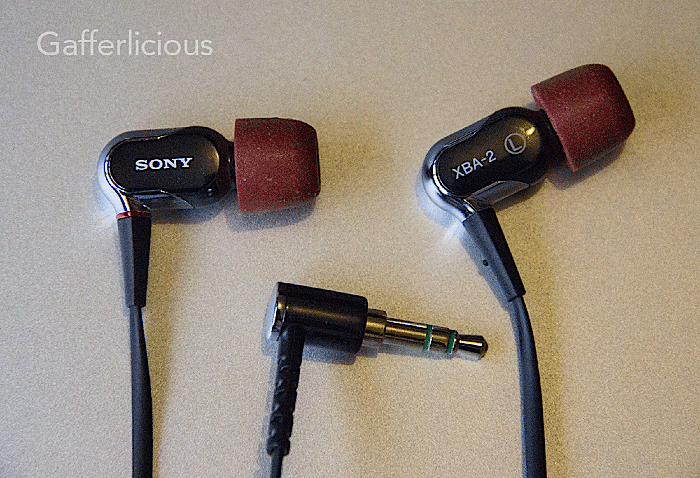
I will compare these to the other IEM's I own (Sennheiser IE6 - which are Dynamic Drivers not Balanced Armatures like these). To summarise, I will then score them on a scale of -5 through 0 to +5 (with -5 being "an absence of...", 0 being "neither too much nor too little" and +5 being "lots and lots of....")
Accessories & Fitment: Firstly, in order to get the best out of these earphones, you really need to experiment with correct fitment. Simply sticking them in your lugholes and hoping for the best won't work. If you do that, you'll probably end up with no bass, poor sound leakage, imaging and treble.
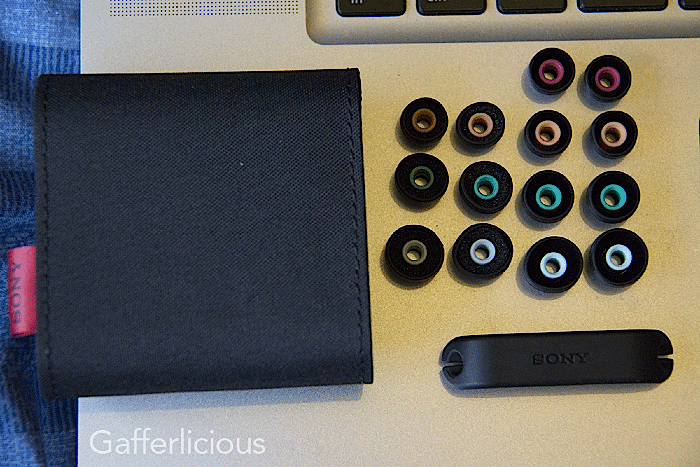
These come with a nice smart "semi-hardened" case to keep them in and with lots of different sizes of silicon tips to help you size correctly for your ears so all you need is time and patience in order to fit them correctly.
First thing I did, however, was to pack those away and get out my Comply 200-series foam eartips (never leave home without them) and use them instead (so my review is done with those inserted).
However, the accessories I got with the IE6's was far better, including double flange tips and a metal case to keep them in plus a cleaning tool (remember, the IE6 retailed at around £140 RRP but the XBA2 is £40 more at an RRP of £180 so I was a bit disappointed with what was included for a "nearly £200" set of IEM's to be honest).
Fit 'n' Finish: I think these look lovely, definitely better than the IE6's which appear cheap and plasticky in comparison. You're meant to be able to wear these either looped over the ear or dangling down classic style. However, unlike the IE6's these have an asymetrical y-cord so I found a better fit to be straight down with the right wire looped around your neck. The cord itself is oval in cross section and meant to be one of those "tangle free" jobbies but overall it feels flimsier than the more robust IE6 cord.
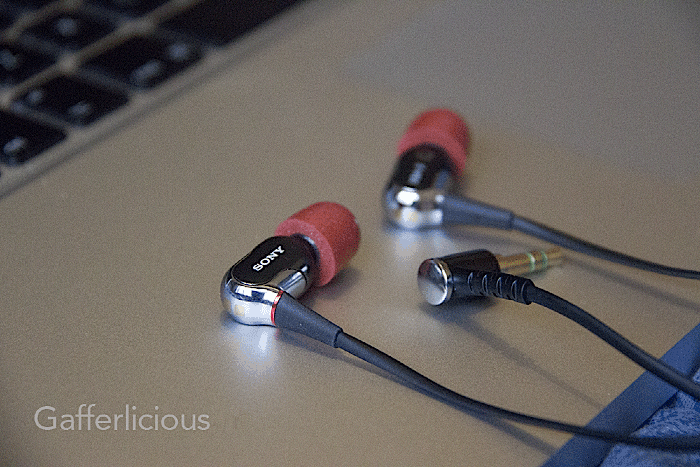
Overall I'd give the metallic finish of these a big thumbs up - they look understated but classy as hell.
BA vs DD: These contain a single full range Balanced Armature driver along with an extra bass driver for added depth. Otherwise the frequency response should be fairly flat across the board up to about 10kHz.
The IE6 Dynamic Driver OTOH is a single full-range diaphragm.
Treble: Sound is remarkable open and "clean" sounding. Definitely not recessed and not lacking either. However, if driven loud and hard with, say, dance or drum'n'bass, I detected a bit of splashiness thrown in. This was only "cured" by turning the volume down a tad. After a lot of experimenting, I figured out that it was merely my source music...320kbps MP3. Switching to 192kbps AAC only showed a slight improvement. Switching to FLAC showed a MASSIVE improvement. Everything smoothed out and sounded much better. Basically, it appears these IEM's will reveal any discrepancies in the source - bad compression in, nasty sound out. If you want to listen to the majority of iTunes downloaded music I'd probably give these a miss. Anything converted at a significantly higher bitrate sounds MUCH better.
The IE6's treble in comparison tend to sound a little dark so I would give the XBA2= 0 (nice and smooth) and the IE6= -1 (slightly veiled)
Midrange: Nice clear vocals but I think the IE6's have more weight to the midrange than these do, again at the expense of making voices sound a little more veiled than the Sony's.
XBA2= 0 (fairly neutral as shown in freq plots), IE6= -½ (slightly veiled but better depth to voices)
Bass: If you listen to these after immediately having tried the IE6's, they sound thin and anaemic....but after a few minutes, you really can hear nice deep bass. It appears missing at first because it's not at all flabby and bloated and doesn't overwhelm the other frequencies. Nice and tight (to coin a phrase) is what these are. So for instance, listening to Dubstep on the IE6's you get an abundance of head-shaking bass in comparison but on those (IE6) it can tend to overwhelm the mids and the treble which then gets recessed (see above). The bass on these OTOH is fast and tuneful and DOESN'T overwhelm the upper frequencies, it's there and you can feel it, although it's not as abundant as what you get with the IE6's.
XBA2= 0 (neither emphasised like many IEM's nor absent - "the neutral amount"), IE6= +4 (this is where dynamic drivers shine and the Senny's are typically good here).
If you really want to hear what the XBA2's can do at their best, try the "Light Up (The World) (Benny Page Extended Edit)" track by Yasmin - nice and deep "enough" and FAST (provided they're fitted correctly).
Listening at Volume: My iPhone goes from 0-16 on the volume range. With headphones in situ, the last 5 levels are coloured red (lvl 12-16 inc.) and the one before this is coloured yellow (lvl 11). These are there to presumably indicate very high listening levels.
You can calculate your headphone's Sound Pressure Level at maximum volume by using this equation:
Volume SPL in dB = S + 10x log10(V2/R) or S + 10x log10(P)
Where S is the sensitivity of the headphones (108dB @ 1mW for the XBA-2), R is the impedance of them (12Ω for the XBA-2) and V is the voltage output of the device/amp (an iPhone gives about 1volt RMS). If all you know spec wise is the power at the outputs of the amp P then you can use the right hand side equation.
So I would be getting 97dB for an XBA-2 via an iPhone. The XBA-2's start to distort a very tiny bit at max volume whereas the IE6's don't distort at all (which, at max volume according to this equation, would be even higher at about 103dB). Now I know you shouldn't listen at very loud volumes anyway (to avoid damaging your hearing), but the point is that the IE6's can go louder with no issues, whereas the XBA-2's are better at medium to low volume.
Overall: Would I get these again? Well, at the price I paid (about £100), I think they're good headphones and I agree with other reviews that have commented on their neutrality and open sound. Having said that, they'll ruthlessly reveal poorly compressed source music and I found listening to the actual CD or a lossless digital version really improved things so YMMV. I also think they're stereotypical Balanced Armatures that sound clearer with good imaging at the sacrifice of less bass impact than Dynamic Drivers.
If you like deep bass, go for dynamic drivers from the likes of Sennheiser...
If you like an open and more neutral sound with smooth highs then you'll like BA's, I think these are a decent entry level pair to buy...
...overall for around the current £100ish price, I'd give them 8 for their neutrality and excellent build quality, minus 1 for their poorer showing at higher volumes and fussiness with source quality...giving them 7/10.
Westone 4R

I finally succumbed and bought a pair of premium Balanced Armatures. My choice was between the Shure SE535 and these, with the Shure's having 3 balanced armatures (treble, midrange, bass) and the Westone's having 4 (treble, midrange, 2x bass drivers). The Westone's won!
Price: Firstly, these retail in the UK at £450. That's a LOT of money for a pair of headphones, even more than my Sennheiser Momentum's. Luckily, I only paid £218 by buying direct from an authorised dealer in the US (inc. FedEx tracked delivery and customs duty). Doing it like this means I still get my 2 year warranty and can be sure I have a legitimate product (I would advise against buying from grey import areas such as Hong Kong if you're going to spend this much).
External Packaging: As you can probably tell from the picture above, these aren't the most luxurious in terms of packaging. Not only does the retail box not look like a premium item, it actually looks like something I would've expected to buy from a carousel stand in Tesco. You get a very basic cardboard box enclosing el-cheapo plastic inserts. Does this matter to me? No - but it's worth mentioning to prospective buyers that it looks a bit disappointing from the outside. Also be mindful that, coming from across the pond, expect minor dents and blemishes in the outer cardboard during transit. Again, does it matter to me personally? No - but there will be some out there who are quite upset at first glance after having spent this much, but please don't let it put you off. They protect the contents and the contents are all that matter to me.
Accessories & Fitment: The accessories vary depending on when you bought your earphones. Earlier models came with a black carry case, information CD and triple flange tips. Newer production runs come with a dayglo orange carry case, no information CD and no triple flange tips.
With that mentioned, I think i'll talk about the case. It's completely weatherproof and looks to be bomb-proof. Westone call it the Monitor Vault, and I think that description is apt. This has to be by far the BEST case I've come across for functionality and protection. It's the kind of thing you'd expect 3rd parties like Griffin to come out with. Once opened from new, you'll see it contains all the other accessories but it's primarily designed solely for the earphones alone. This is a common sense approach that I like that many other manufacturers ignore, with their bulkier offerings that aren't as well made and are designed for different tips, cleaning tools, the kitchen sink etc that make a chore out of removing the 'phones on-the-go for actual use. This, on the other hand, has the thinking that once you've selected your tips, you don't need to be lugging all that other gubbins around. They can stay at home and all you need space for is the 'phones. It's made from high impact polymer and has a very secure clasping mechanism that will survive any bag. Overall, this definitely feels premium to me.
On to the rest of the accessories and you get a great selection of "comply-like" foam tips as well as the usual standardised rubber tips most 'phones come with (5 sizes of each). You also get a ¼" adapter, in-line volume control and a cleaning tool (wire tip one end, brush on t'other). Beyond that, the 'phones already have foam tips on which are medium in size, so you may just be good to go out of the box like I was.
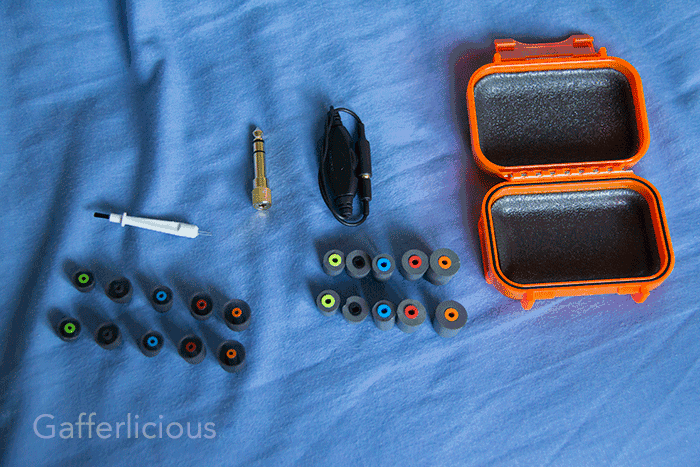
In terms of fitment, I can only stress again that sizing the correct tips for your own ears is essential. Too small and they'll fall out. Too far in and your bass may reduce. Too large and you may not get a seal etc etc. 90% of people will go with medium sizes, but make sure you don't fall into the 5% either side. If you want to go ghetto, you could easily DIY your own foam tips from cheap ear guards or buy 3rd party offerings from the likes of Comply (100-series) and such. Just make sure you get a good seal in your ear canal.
The rest of the earphone (plastic body) ends up nestling gently in your ear between tragus and concha. The wire has a hardened sleeve around the first inch or so that is pliable and allows you to mould it around the top of your ear to ensure it stays snugly in place. The wire then loops round the back of your ear and down. Wearing these proves to be so comfortable that you end up forgetting they're there. Not only that, but the noise isolation is fantastic. Also, for those that wish to do so, you can lie on your side and sleep with these in without any discomfort (e.g. if you sleep listening to audio books).
Overall, very comfortable and light (I just spent an hour walking around town with them on and they're great).
Fit 'n' Finish: In the pictures, they just look like boring plain black plastic. In real life, they're high quality gloss black with a really nice braided wire. The wire is worth mentioning because microphonics (transmitted sound when you brush against it) is reduced to very little/none and also they're changeable. This is important because should you damage it, it means the whole set isn't useless, you can just replace the wire. You can also upgrade the wire (to something like Baldur mkii wire) but I'm currently keeping mine stock. The wire is symmetrical and has a clasp that allows you adjust the 'Y' length.
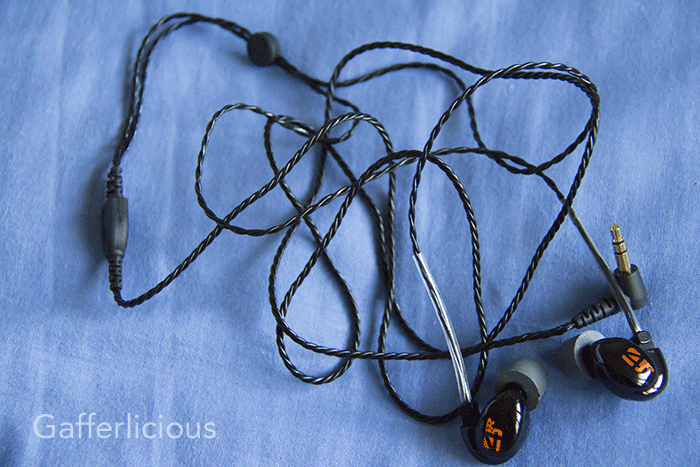
In terms of overall finish, I think the Sony XBA-2's looks classier, but these are great in their own right (and certainly miles ahead of my Sennheiser IE6's).
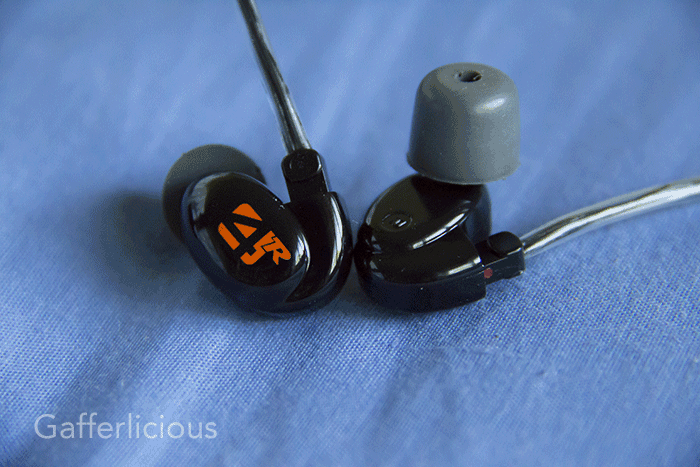
The Sound: Now on to the most important part of the review, how do they sound? These contain 4 balanced armatures. That's one each for treble and midrange and two for the bass alone. Despite this, the frequency spectrum should be fairly flat and neutral. I can't really split this up into separate frequencies because as a whole, it all sounds so cohesive, and i'll probably end up putting the wrong comments in the wrong section, but I'll try.
Treble: Treble is extremely clear and razor sharp. By that, I mean that there is no sibilance and it makes the music sound very open and "clean". It also helps portray a wide open soundstage that helps you pick out individual instruments. Transients are full of attack and these 'phones have no trouble dealing with high energy music. Also, unlike the Sure's, there's no high treble roll off, it's just "there" where it should be and extends well into the upper registers. However, stick on something more laid back (like Madeleine Peyroux) and everything shines where it should, with her voice appearing mid-centre. Like most BA's, the sound is very revealing so you'll also get all the nastiness associated with poor encodings (e.g. splashy treble). To really shine, you'll need a lossless codec and everything smooths out and sounds as it should.
Midrange: Nice and clear, with the midrange melting effortlessly into the treble. The whole sound comes across as "lush" or "velvety". Vocals are especially well catered for, being only a tad behind the 535's but well balanced and quite forward with the right kind of music. I especially like the fact the everything is placed so well on the soundstage. You end up effortlessly being able to pick up individual voices and instruments and imagine them in your head at specific points in the soundstage. In terms of analytical, these have to be amongst the very best.
Bass: If you listen to these after immediately having tried some Sennheiser Momentum's, they also sound a bit thin and anaemic. It takes a few minutes to key onto the nice deep bass, which initially appears absent because it isn't shouting at you "look at me, look at me, look at me". That's the point, the bass you hear is the ACTUAL bass encoded on the track. No more no less. The reason for the 2 bass drivers is not to give bloated bass, but is instead to effortlessly allow accurate bass that starts and stops on a dime. It's so good, in fact, that you can easily delineate individual bass-lines layered on top of each other in complex tracks (e.g. Dubstep/Garage tracks).
Yes, these can't match my Sennhesier Momentum's for bass (power and extension) but those are full sized headphones...for IEM's I simply haven't heard better than these.
Detail: Initially they're almost underwhelming at first listen, but this is because they only show you what's there. It took an hour or so for me to appreciate how good this was because it felt like I was hearing songs without any filters in front of them. What was recorded was what's heard and it's that neutrality that makes these lovely to listen to and lets the detail come to the fore.
You end up picking out things you've never heard before, even on well known songs. I ended up spending 4 hours when I initially unpacked them simply going through my songs randomly just to hear the "new" bits. For instance, Pride & Joy (Marvin Gaye) you can precisely pinpoint the piano to the point of individual keys being hit. I know that sounds silly as it's there regardless of the headphones used, but unlike other 'phones, the instruments don't all just merge together into a "wall of sound". Everything is clear and precisely positioned. You could argue that they're clinical, I'd say that they're simply enjoyable with all of the detail from the recording being presented to you effortlessly.
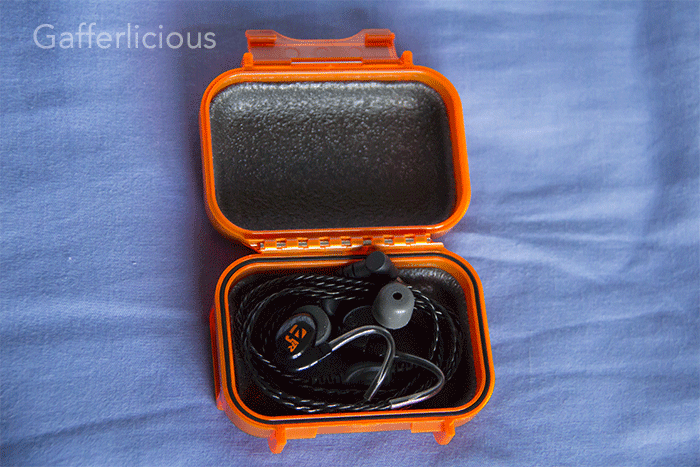
Overall: Would I get these again? Well, even at full RRP of nearly £450 I wouldn't be too disappointed. They are so well balanced and precise that they're almost like the IEM version of my Sennheiser Momentum's (no small praise) and are a definite favourite already. A nice word to sum up how they present music would be "honest". The downsides are mainly that they can be too ruthlessly revealing so iTunes bought music and poorly compressed mp3's are not ideal. You want lossless for these to shine.
I would also add that I feel you don't need an amp to drive them. Mine went happily loud enough with my iPhone 6 alone. Having said that, adding my Fiio amp helped with headroom a bit but if you don't have a dedicated amp I wouldn't be put off from buying them at all...and for the price I paid they definitely have to get a solid 10/10 from me.
Bowers & Wilkins P5
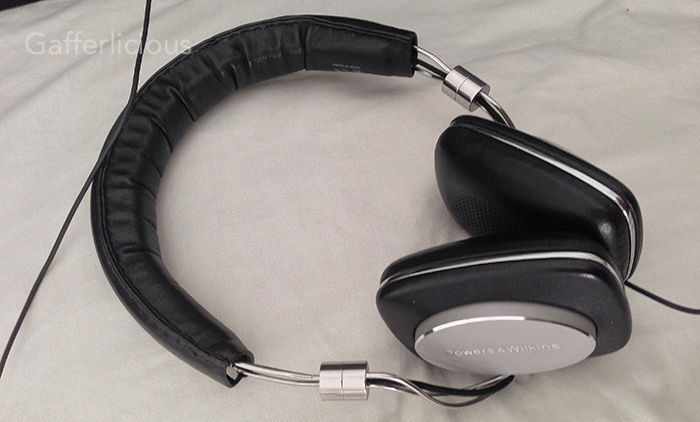
All I can say is that these are very stylish headphones. They have a beautiful chrome finish mixed with leather that makes them probably the nicest headphones I have seen to date. Not only that, but the leather is very soft sheepskin making them the most comfortable "on ear" headphones I have ever used. The pads are held on magnetically making it easy to replace and/or wash them. The cable is changeable between standard and iPhone type and it comes with a padded carry pouch.
With regards to sound, these are great with the right application. They have a smoothly rolled off treble and a mid bass hump, meaning they're not ideal for serious Hi-Fi use (surpassed by the Momentum's neutrality in that) but the pleasing frequency curve makes them ideal for portable use with an iPhone or iPod. They're fairly easy to drive and have good passive noise cancelling meaning they're perfect on-the-go, for instance when on public transport.
Overall, I would rate these as an extremely comfortable, good sounding and lightweight pair of headphones for portable use but not for serious audiophile listening. I would give them 7/10
RevoNext QT2S and TRN BT20S
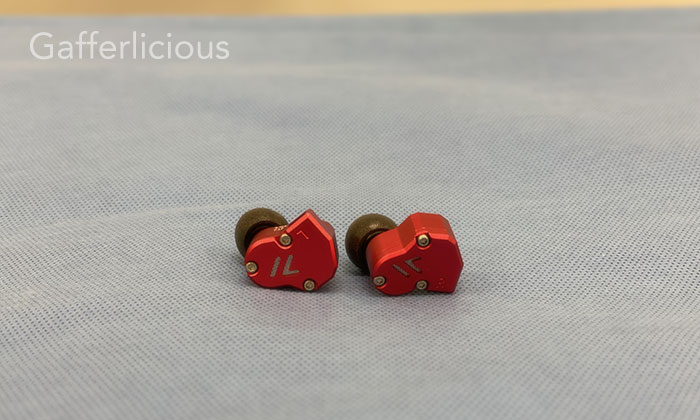
An earphone type I'd never tried before were hybrid ones. The idea is to get lots of bass which balanced armatures find difficult to do (but dynamic drivers cope well with) coupled to clarity and accuracy of the top end which dynamic drivers find difficult to do (but balanced armatures cope well with). To that end, these IEM's have 2 dynamic drivers (one for deep bass and 1 for bass to low mids) as well as a balanced armature (for mids to treble) in each earpiece, making it a triple driver arrangement...let's see how they get on:
Price & Packaging: Firstly, a triple driver from an 'established' brand such as Sennheiser or Shure would normally retail at the £350-£450 mark but these came in at a paltry £40 (mine were discounted further to £27) which must make them bargain of the century. Packaging was sparse with only the earbuds themselves, cable (you can choose from plain cable or one with a remote for £1 more), a set of silicone eartips (S, M, L) and sparse instructions all in a small cardboard box. You won't get more basic than this but at this price I'm not complaining. I prefer memory foam to silicone so immediately got a pair of Comply tips to go with them as well (outer edge to edge nozzle size is 5.5mm in size).
Fit 'n' Finish: Really good quality here, being made of anodised aluminium, it was surprising how good these are and feel in terms of quality. They are metal but only weigh about 6.5g each so aren't super heavy in your ears. 3 small screws hold the external housing in place and the overall look oozes quality (I'd never heard of this brand before but they're impressive out of the box). It's worth noting that the QT20S (0.78mm) is the same as the previous QT20 (0.75mm) apart from the cable connector size indicated (all drivers and materials are otherwise identical).
Usage: I bought these for wireless use with my iPhone 11 Pro which doesn't have a headphone jack and when using 3rd party conversion dongles, won't route phone call audio through the wire (even if using the OEM Apple dongle which does, you still need to pull the phone out of your pocket if there's no mic/remote built in) and sound quality can suffer when going through so many connections. I therefore was not going to use this wired anyway (see below) but have reviewed that way to get the best possible sound for this review.
Bass: Having 2 dynamic drivers you would think that the bass on these is plentiful and you won't be disappointed. Lots of bass, including deep sub bass that extends very well. The mid-upper bass going up to the midrange is very well controlled and because most of the bass is much lower, this upper bass remains clear and controlled (i.e. the bass doesn't bleed uncontrollably into the mids). Overall a deserved 5/5 for the low end here.
It's worth noting that there is a small vent hole near the inner housing section of the nozzles and the amount of cover of this hole by your head, the more the bass gets increased. Cover the hole completely (e.g. with a small bit of tape) and you can increase deep bass by about 3dB without affecting the midrange or treble at all.
Midrange: Not recessed and allows vocals to sound nice and defined. Granted they're not quite as good as the Westone's for clarity but very good all the same. 3.5/5 for mids.
Treble: Treble is very detailed and sharp. There is a noticeable augmentation at about 11kHz which means some tracks can sound a bit peaky and sibilant which is probably exacerbated by the balanced armature dealing with this range situated in the nozzles rather than further back near the dynamic drivers. Otherwise very listenable if a bit fatiguing for long periods. Detail is good although again, not up to par with either my Westone's or my Sony's. 3/5 for the high end here.

Overall: If you ignore the price and concentrate on the IEM's alone then these are very competent performers that would be a recommended buy. If you take price into account then these are an amazing find that are simply too good to miss. I would give them a well deserved 7/10. There are many 'ChiFi' IEM's appearing now including the same hybrid tech (as well as pure DD or pure BA ones) that wouldn't look out of place in high end boutiques but made at extremely low cost. Rivals include the likes of KZ/CCA/Mifo/Tin/etc etc so there is plenty of choice out there for you.
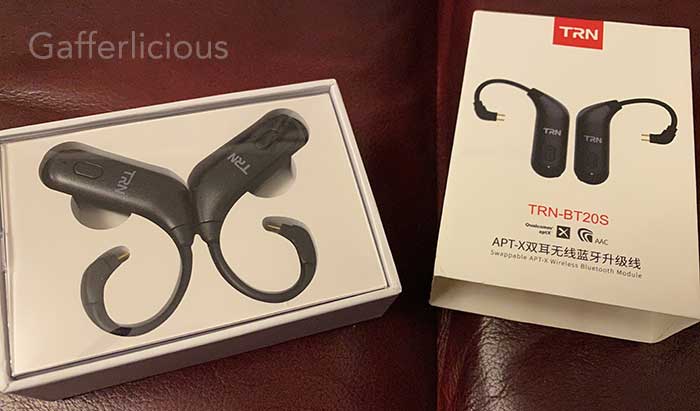
Making them Wireless: It's fairly easy to make these headphones wireless. They have detachable cables with Hi-Fi 0.78mm dual prong connectors (the other main 2 types being 0.75mm or the circular MMCX kind). The TRN-BT20S dongles also have that exact connector and so can be plugged into these to make them wireless. They have BT 5.0, AAC (for iOS) & APTx (for android) and will last 8hrs on a charge. Unfortunately these codecs are not lossless and despite what you read in the media, even ATPx HD and AAC+ (HE-AAC) are not lossless (no BT codec is lossless currently, they are all lossy with the newer ones simply allowing for higher bandwidth but still exhibiting degradation through compression). This means that sound quality is not on par with any wired system with a slight loss of dynamics and detail in music when comparing wireless to wired. They also introduce the very occasional interference now and again but this is rare, overall they're fairly noise free. They also have DSP noise cancelling for voice calls (not for normal music listening) and voices do appear clear and distinct through them. Pairing them up can be fiddly and the instructions aren't the most comprehensive but they work well with modern "jack-less" iPhones and allow you to take and end calls as well as skip tracks from a simple press of the button on the side.

They are also very comfortable to wear for long periods of time so much so that you even forget they're there and they have a decent runtime of about 8hrs per full charge. So overall great for the convenience of wireless but not so much for absolute SQ, I would give these an average 5/10. Another great aspect is that these (like a lot of this new wave ChiFi) come in at a very wallet friendly £38. In fact the total cost of what ends up being true wireless hybrid IEM's is therefore £65 of both together with a build and sound quality to rival the established brands at five times the cost so I would recommended them.
Sennheiser Urbanite
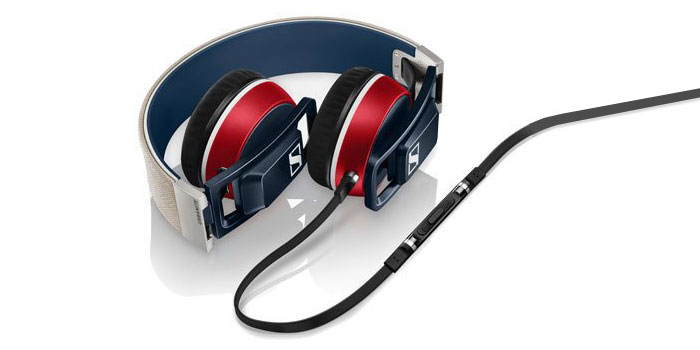
These are an "on ear" (like the B&W P5's) rather than "over ear" design (the larger over ear version being the Urbanite XL). From a sound point of view, they have a boosted bass presence, another hump in the mid treble and a corresponding dip in the midrange. They appear to be competing with the Beats headphones with this characteristic frequency response and thus, I would not consider them Hi-Fi ...more like mid-fi for the millennials in the audience. If you like plentiful, deep overpowering bass, exaggerated highs with little midrange and are an audience for this specific sound signature, then these are worth a look over their Beats EP/Solo2 rivals.
I would give these an average 5/10
Enacfire E90
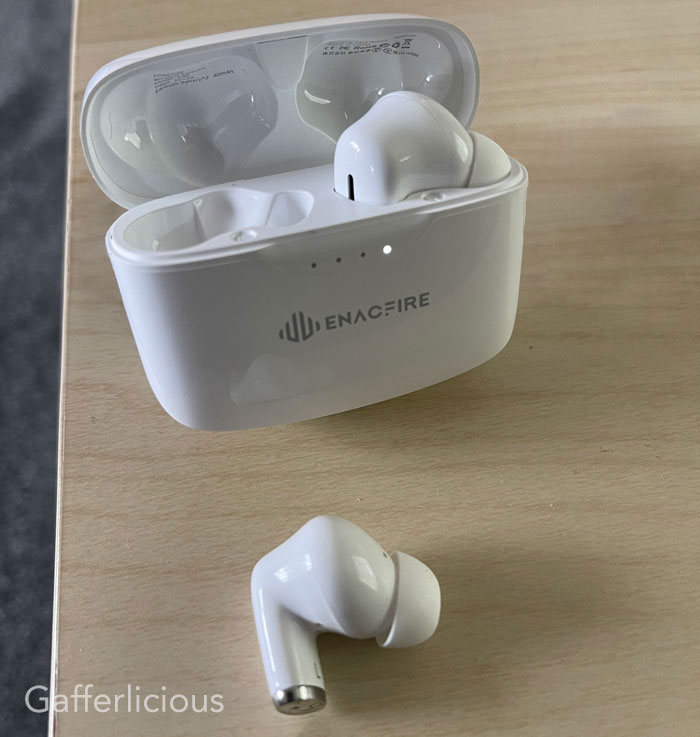
Just bought these to replace my headband headphones that failed 1 month after the warranty ran out (as usual with current tech). Was happy to see a 2yr warranty and a good price so I bought these replacements.
Look/Feel: These genuinely look and feel as solid and well put together as my Apple AirPod Pros so I am VERY happy with the fit’n’finish. The case has a decent weight (meaning it won’t be flying all over your desk) and the hinge lid has a nice magnetic snap to it (as do the headphones when they clip in and out). The charging indicator is easy to read and I like the fact that they have included a USB-C port rather than a fiddly micro/mini USB plug which my previous headband headphones had (and were really difficult to connect into for charging). 5/5 for look/feel.
Sound Quality: These are VERY bass heavy headphones. So much so that it’s quite bloated and overbearing, drowning out any midrange. The treble is shouty and imprecise, nowhere near as crystal clear or detailed as my other headphones such as my Sennheiser Momentum’s, Sony XBA-2’s, Westone 4R’s, RevoNextQT2S’s etc etc. They sound like Beats by Dre did when they first arrived on the scene and before Apple engineers started improving the sound quality. This lack of tonal balance and accuracy means I wouldn’t actually use these for listening to music at all and would prefer my more accomplished head/earphones instead (so they don't rate very highly for music). However, I am not using these for music at all. I listen to audiobooks/youtube spoken word etc to get to sleep at night. For this, it’s a perfect idea to have lots of bass and little treble as you’ll be able to doze off to sleep with a dull voice better than a high sharp pitched one. So actually, for what I use it for it specifically meets my needs so I would give it a 5/5 for night time audiobook listening but it's only a 2/5 for music, .
Controls: continuous touch left earpiece for volume down, continuous right for volume up, tap once to play/pause, tap twice on right to skip to next, tap twice on left to skip back, three times for Siri and 4 times for game-mode. The touch pad is on the “shoulder” of the earpiece and appears to work well. There is a discrete “ping” when you reach the extreme ends of the volume (unlike my previous headband which announced the volume e v e r s o s l o w l y). So the controls are responsive and intuitive but they can very occasionally miss an input (e.g. recognise 3 taps as 2 taps for instance) - so I'll score them 4/5 for controls.
Charging/Runtime: unfortunately these get nowhere near the advertised runtime. Listening at night on the LOWEST volume possible before silence (ie 1 notch) and I’m getting about 4 hours out of these not the much advertised 8 hrs. The case isn’t that much better either because you don’t get anywhere near 5 charges out of it, it will actually only charge the earbuds twice before running out of capacity itself. Charging time is about 1.5-2 hrs for both the case itself and the earbuds. I like the fact that the case lights indicate the earbuds are charging as well as the case state of charge. However the very poor runtime of barely half what is advertised for the buds and less for the case mean these get only 1/5 here
Comfort: They’re very comfortable in ear and don’t appear to move when shaking my head around. Of course, rubber tip sizing is important here but even the standard “medium” they come with appear OK. I can upgrade to Comply foam tips easily enough if needed. Lying down they are comfortable when on my left side or my right side so sleeping with them won’t be an issue for short periods of time. For longer periods of time there is some discomfort so I have to change position and sometimes take them out completely but they’re still OK for in ears - 3/5 here for my specific usage.
Phone Calls/Noise Cancelling: I don’t use it for phone calls, only for night time listening so I can’t comment in detail but the one phone call I did make whilst testing appeared to have no issues and I was understood without problems. It is sold as being noise cancelling but this is only meant to take effect during phone calls, NOT during normal music listening. The actual CVC 8.0 Noise Cancelling is barely noticeable and not a patch on, for instance, Bose Quiet Comfort active noise cancelling headphones. Annoying that it's not for all uses and only reserved for calls but at least it’s less of an issue at night when trying to sleep (there isn’t lots of background noise that require cancelling so maybe that's why I don't miss it) - 1/5 for noise cancelling.
BT Range: Uses BT 5.0 and seems to have a further range than my old headband headphones, but again, not an issue when I'm lying in bed and my laptop/phone is playing audiobooks and charging right next to me. Also, when out and about, if you want to use them your playback device is also usually on your person so range won't be an issue there either. So nothing bad but also nothing special - a slightly better than average 3/5 for range.
Game Mode: Mentioned in the manual but not explained either in the shop's description, Enacfire website or E90 manual. You tap the earbuds 4 times to enable or disable it.... but what is it? It’s simply Enacfire’s low latency mode (75ms) for better lip syncing when playing games or watching movies. I’m assuming it’s switchable because it requires a reduction in the advertising interval within the BT codec which therefore uses more energy to function so you have the option to turn it off if you’re not playing games and want a longer runtime. As the normal latency for other implementations such as APTx LL (40-60ms) or LLAC (30ms) is much better than Enacfire's, this only shows they can't even get this right (although they get a point for trying). 1/5 for latency.
Overall: A bit of a mixed bag really. For the cheap price of £22 coupled with excellent fit and finish these are good value for money. For my specific listening use of night time audiobook listening they get an above average 6/10.However, I would not recommend them for normal music listening because looking at musical sound quality alone these are quite poor and would barely score 3-4/10.
Apple Airpods Pro 2
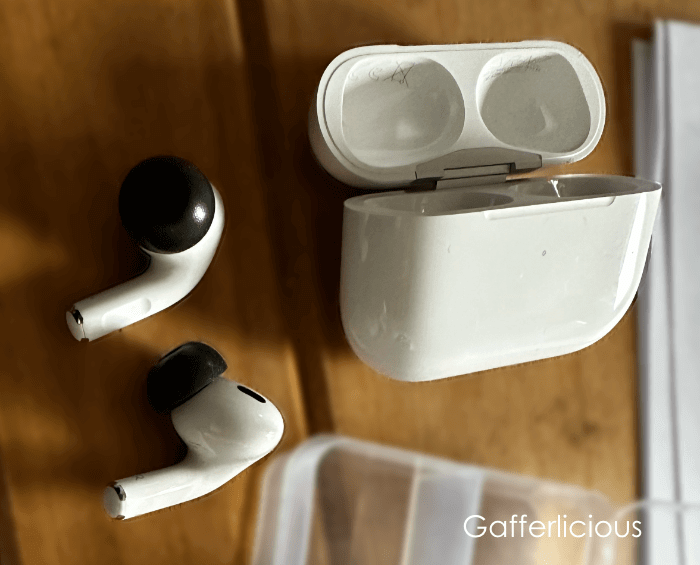
I managed to get these on sale here in the UK (where current Apple products usually never go on sale anywhere) for £199. I wanted something that simply worked with all my Apple devices and also sounded good to boot. There's not much to say about this so I'lll be brief.
Case, Battery & Fitment: I am surprised how small the case is yet it feels substantial and weighty, a quality item. I like the fact that the lid has a very positive click shut to it. Battery life is substantial (unlike most chi-fi wannabees out there) and I can get close to Apple's claimed runtimes. A solid 5/5 for case quality and runtime.
Before I move onto sound, the most important aspect of good SQ for any earbud is good eartip seal. Apple have a great tool in the iPhone of checking for a good seal automatically. This works quite well and resulted in me immediately not using the supplied tips and opting for memory foam ones instead.
Bass: As mentioned, without a good seal, SQ suffers but of the 3 ranges, bass will suffer the worst. Ensuring a good seal and the Bass in the Airpods Pro 2 is fairly neutral - plenty when needed but not overblown and fairly accurate too. I'd give them 4/5 for the bass.
Midrange: Fairly neutral again. Unlike many alternatives/rivals (like the Sony WF-1000XM5, Bose QuietComfort 2, Beats Studio Buds + etc) that de-emphasise the midrange, it's pretty on point here. This is important because this means that most vocals will be front and centre in most tracks, not hidden in the background or veiled by the accompanying music. A 4.5/5 for midrange here.
Treble: This is where the Airpods Pro 2s slightly lag behind the competition imho. There's a slight de-emphasis of treble resulting in the earbuds sounding very "polite". You could easily fix this in the EQ settings but you shouldn't really need to at this price point. The closest SQ rivals to the Airpods are Denon Perl Pro and KEF Mu3 earbuds and they both better the Airpods in treble accuracy. The trade off is that despite being slightly less sparkly than others, these are very listenable earbuds. I can literally listen all day and have no ear fatigue, which makes these appeal to a wider audience. I score the treble 3/5.
Listening Modes: These aren't as good as the class leaders but the ANC is great nonetheless, managing to block out a large amount of background sound. The Transparency mode is also very well done allowing you to hear both the song and your environment. However, where this really shines is in the adaptive mode. It will ANC the surroundings until it detects you talking, where it will reduce the music level and switch to Transparency mode. Once you've finished your conversation, it will automatically revert to full music in ANC mode again. Works brilliantly well and something I haven't seen replicated in rivals so it gets a 4/5 for this.
Overall: These are great everyday use earbuds that have a long battery life and great SQ despite not reaching the heights of true hi-fi like the Westone's. They get a commendable 8/10.
Portable Headphone Amp/Remote for iOS devices
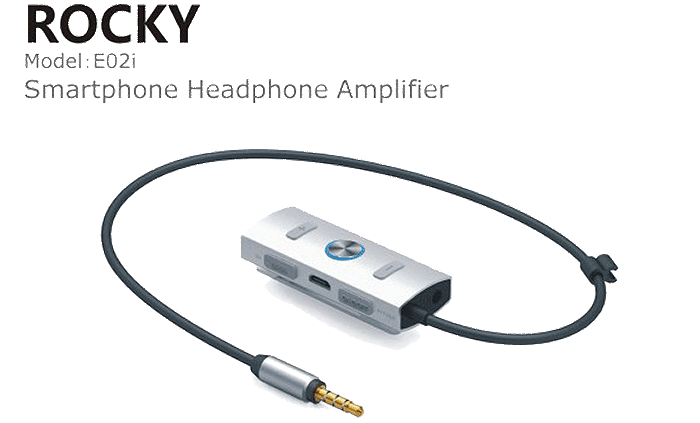
I use a small portable amplifier/remote controller to listen to tunes on the move. The Rocky Fiio E02i has a few advantages when being used with an iPhone:
- My iPhone is in a case, which means many headphones/earphones simply won't push fully into the 3.5mm jack port. This solves that issue in that the jack is very slim and allows a properly seated connection even in most cases. The possibly bulkier headphone can then seat snugly into the Fiio.
- iPhones have an EU volume limit which can be slightly superseded by adding in a moderate amp like this.
- The E02i has a "Bass Boost" switch which nicely lifts the low end that many headphones cannot produce well (& can be turned off when listening to decent headphones).
- It also contains a mic, allowing you to field calls without lifting your iPhone out of your bag/pocket.
- It even has a full remote control facility allowing you to skip forward/back, FF/REW and change volume.
- It's easy to recharge and has good battery time, which means you don't have to run the iPhone itself so high and can thus preserve some iPhone battery life - when the Fiio runs out you can still use the remote control functions and listen at "normal" volume.
My Audinst USB DAC Review
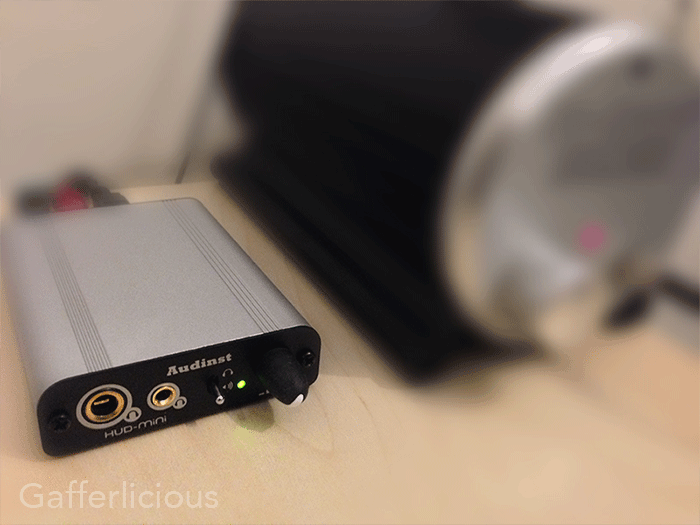
Of course, I mainly use my headphones for portable use or listening at night to either TV or my iTunes music. In order to specifically be able to enjoy better music on my laptop (a 2009 Macbook Pro, so it's not terrible in the audio department) I have bought a USB asynchronous DAC and amp called the Audinst HUD-mini. The main focus of this being that I have recently started listening to better encodings via iTunes with better headphones (proper music listening is relegated to my Hi-Fi, this is just for convenience so I needed portability).
The Audinst (I'd never heard of this company before) runs purely off the USB and when you plug it into the laptop, it shows up in the menubar as External SPIDF Interface (⌥ click the loudspeaker icon in the menubar to get a list of possible outputs). This means the laptop isn't using it's own amp any more (so volume controls are greyed out and you have to use the volume knob on the external amp). No drivers to install, it just works. Better still, you can still use the equaliser in iTunes to modify the frequency curve (although, it sounds so good without that I turned it off - see below).
N.B. Remember to use "Audio Midi Setup" in Utilities to set the Audinst's USB SPIDF signal to 96000Hz, 2ch-24bit when playing your 24/96 Tracks.
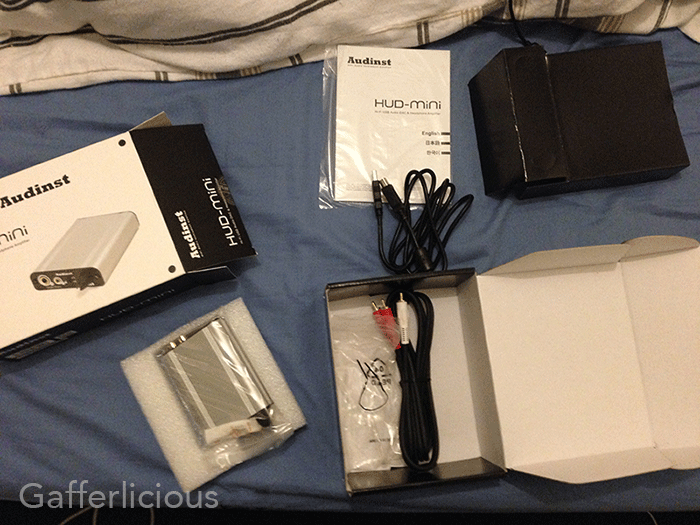
As you can see from the piccie above, it comes well packaged from South Korea and is marked as $10 so you won't get stung by customs (check this with the vendor first). I bought mine from an Amazon seller for the princely sum of £84 inc. delivery, which took 3 weeks.

It uses a Burr-Brown 24bit/192kHz DAC with an output OpAmp that is socketed so you can switch out with other ones as you want. Having said that, the built in National Semiconductor LME49860 OpAmp sounds brilliant on it's own, so I haven't bothered rolling it. It is also asynchronous with it's own TCXO so it isn't relying on your laptop's clock output as it has it's own, which should theoretically give better sound quality
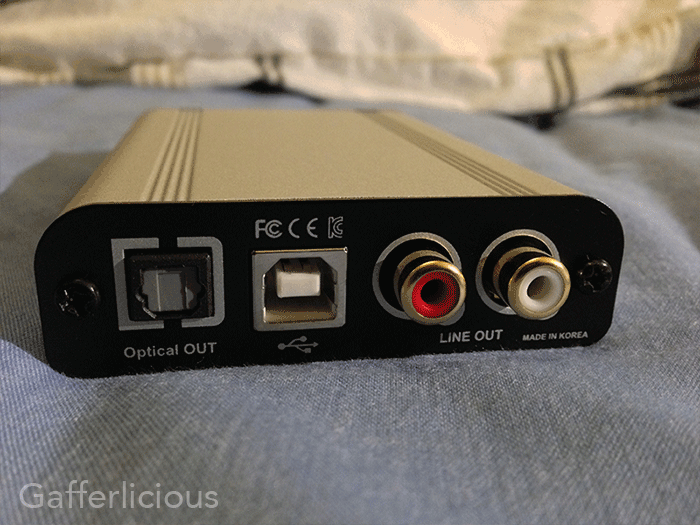
From the back you can see it also supports the ability to pass the DAC output to an external amp. This is switchable from the toggle on the front panel which is important because the Audinst itself is on par with what the MBP can generate from it's own headphone out...i.e. the amp in the MBP is only very slightly more powerful than the amp in the Audinst, so if you want to go louder, you'll have to amp separately and use the Audinst as a DAC alone. Luckily, I had an old Musical Fidelity X-Cans (slightly modded) lying around so I used that 😏.
Sound: Right, on to the most important part of the review. My headphones have been my Sennheiser Momentum cans. To get more volume, I had previously been listening to the MBP through the headphone out (NOT lineout) and then into the X-Cans. This means the digital track is getting converted by the MBP's DAC, amplified by the MBP, sent to the MF X-Cans and amplified again (whilst on it's way going through a 3.5mm to phono converter and pair of couplers with 2 leads either end). The result? Louder but easy to hear sibilance and hiss and interference. Overall, quite poor and something I wouldn't recommend. I then used the Audinst alone meaning that the track was being fed directly/digitally via USB to the Audinst DAC which then converts it to analogue, amps it and sends it to your headphones - a much better signal path.
Result? WOW! No hiss/sibilance, inky black background (with good recordings) plenty of bass and silky smooth midrange and treble. Yes, the Audinst doesn't go quite as high as the MBP alone, but it sounds soooooooo much better because every instrument is clearer and more delineated than before. The soundstage is also widened but more importantly, instrument separation is spot on (similar to what my Westones can do). I found myself head-bobbing as my iTunes appears to have got it's groove on again!
Overall I was extremely impressed...so much so that I almost immediately turned the iTunes equaliser off completely (⌥ ⌘ 2 in iTunes and uncheck the "on" box).
However, volume was loud but I wanted to see if a beefier amp would change things, so I used my Kelvin K2 interconnects to hook the Audinst up to my MF X-Cans and bypassed it's own internal amp.
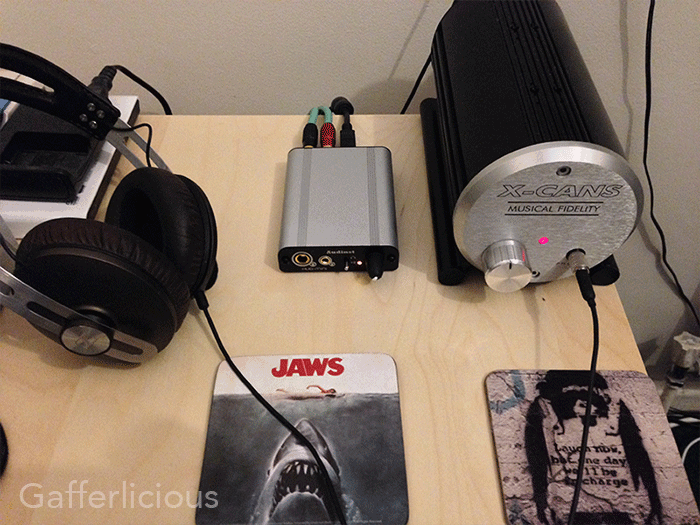
The result? Bass gets more meaty at the expense of a slightly more recessed midrange (which is so much more up-front-and-in-yer-face with the Audinst alone). It's almost as if a teensy weency bit of the PR&T disappears when the X-Cans are plugged in but traded off for better bass. Oh, and the X-Cans go louder as well.
Regarding the Audinst in isolation, the sound quality is fantastic for such little outlay so I would give this a solid thumbs up and say that an external amp is purely optional.
In fact, my order of preference would be:
- MBP → Audinst or MBP → Audinst + external Amp depending on your taste
- MBP alone
- MBP headphone out feeding a lone external amp
- iPhone/iPod alone
